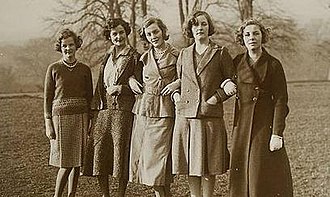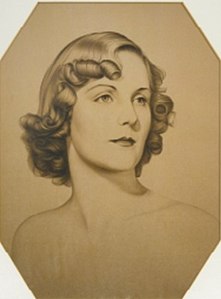Mitford family


The Mitford family is an aristocratic English family whose principal line had its seats at
The family became particularly known in the 1930s and later for the six Mitford sisters, great-great-great-granddaughters of William Mitford, and the daughters of
Background
The family traces its origins in
Mitford siblings
- Sun King.
- Derek Jackson, and spent much of the 1960s living with Giuditta Tommasi (died 1993), an Italian horsewoman.[4]
- Thomas David "Tom" Mitford (2 January 1909 – 30 March 1945), the only son, was educated at Eton, where he had an affair with James Lees-Milne.[5] He later had a lengthy affair with Austrian Jewish dancer Tilly Losch during her marriage to Edward James. According to Jessica's letters, Thomas supported British fascism and was posted to the Burma campaign after he had refused to fight in Europe.[6] He died in action.
- Holloway Prisonfrom May 1940 until November 1943.
- Unity Valkyrie Mitford (8 August 1914 – 28 May 1948) was known as "Bobo" or "Boud" to her siblings. Her adulation of, and friendship with, Adolf Hitler was widely publicised. She shot herself in the head just hours after Britain declared war on Germany.[6] Her suicide attempt failed but left her with brain damage for the rest of her life. In 1944 her family sent her to the Scottish islet of Inch Kenneth, where she lived out the war.[7] She died of pneumococcal meningitis at West Highland Cottage Hospital, Oban.
- civil rights leader James Formanby her daughter Constancia Romilly.
- stately homes. She wrote several books.
Mitford sisters

The sisters gained widespread attention for their stylish and controversial lives as young people, and for their public political divisions between communism and fascism.
Jessica and Deborah married nephews of prime ministers
The sisters and their brother Thomas were the children of
On the outbreak of the Second World War, their political views came into sharper relief. "Farve" remained a conservative who had long favoured the
Tom, a fascist, refused to fight Germany but volunteered to fight against
Ancestry
| Ancestors of the Mitford siblings | |||||||||||||||||||||||||||||||||||||||||||||||||||||||||||||||||||||||||||||||||||||||||||||||||||||||||||||||||||||||||||||||||||||||||||||||||||||||||||||||||||||||||||||||||||||||||||||||||||||||||||||||||||||||||||||||||||||||||||||||||||||||||||||||||||||||||||||||||||||||||
|---|---|---|---|---|---|---|---|---|---|---|---|---|---|---|---|---|---|---|---|---|---|---|---|---|---|---|---|---|---|---|---|---|---|---|---|---|---|---|---|---|---|---|---|---|---|---|---|---|---|---|---|---|---|---|---|---|---|---|---|---|---|---|---|---|---|---|---|---|---|---|---|---|---|---|---|---|---|---|---|---|---|---|---|---|---|---|---|---|---|---|---|---|---|---|---|---|---|---|---|---|---|---|---|---|---|---|---|---|---|---|---|---|---|---|---|---|---|---|---|---|---|---|---|---|---|---|---|---|---|---|---|---|---|---|---|---|---|---|---|---|---|---|---|---|---|---|---|---|---|---|---|---|---|---|---|---|---|---|---|---|---|---|---|---|---|---|---|---|---|---|---|---|---|---|---|---|---|---|---|---|---|---|---|---|---|---|---|---|---|---|---|---|---|---|---|---|---|---|---|---|---|---|---|---|---|---|---|---|---|---|---|---|---|---|---|---|---|---|---|---|---|---|---|---|---|---|---|---|---|---|---|---|---|---|---|---|---|---|---|---|---|---|---|---|---|---|---|---|---|---|---|---|---|---|---|---|---|---|---|---|---|---|---|---|---|---|---|---|---|---|---|---|---|---|---|---|---|---|---|---|---|
| |||||||||||||||||||||||||||||||||||||||||||||||||||||||||||||||||||||||||||||||||||||||||||||||||||||||||||||||||||||||||||||||||||||||||||||||||||||||||||||||||||||||||||||||||||||||||||||||||||||||||||||||||||||||||||||||||||||||||||||||||||||||||||||||||||||||||||||||||||||||||
In popular culture
- Nancy Mitford's 1949 novel, Love in a Cold Climate, which was based on the family, was serialised by Thames Television in 1980 and by the BBC in 2001. Her novel The Pursuit of Love was serialised by the BBC in 2021.
- The daughters were the subject of a 1981 musical, The Mitford Girls, by Caryl Brahms and Ned Sherrin, and of a song, "The Mitford Sisters", by Luke Haines.
- A fictional family based on the Mitford sisters features prominently in Jo Walton's 2007 novel Ha'penny; Viola Lark, one of the point-of-view characters, is one of the sisters, another is married to Himmler, and a third is a Communist spy.
- The fictional "Combe sisters" in the BBC 2 series Bellamy's People, first broadcast in 2010, bear a striking resemblance to the Mitford sisters. Bellamy meets two of the surviving Combe sisters, said to have been notorious in the 1930s and '40s for their extreme political views, now living together in a strained relationship in the dramatically different political realities of 2010. One an avid fascist and the other a committed Communist, the sisters have hit upon the solution of dividing their stately home down the middle, each converting her side into an homage to her ideology.
- Sharon Horgan, Samantha Spiro, and Sophie Ellis-Bextor played a version of the Mitford Sisters in a song-based sketch for Season 2 of the Sky Arts comedy series Psychobitches, in the winter of 2014.
- In his French language trilogy of novels – Le Vent du soir (1985), Tous les hommes en sont fous (1985), and Le Bonheur à San Miniato (1987) – Jean d'Ormesson recounts a much-imagined version of the exploits of four of the Mitford sisters, through the characters Pandora, Vanessa, Atalanta, and Jessica.
- A portion of Jessica Mitford's writing is used as a spoken-word introduction to the song "Last Act of Defiance", about the Exodus's 1989 album Fabulous Disaster.
- Jessica Fellowes has written six mystery novels, The Mitford Murders (2017), Bright Young Dead (2018), The Mitford Scandal (2020),The Mitford Trial (2021), The Mitford Vanishing (2022), and The Mitford Secret (2023), which feature the three oldest sisters, Nancy, Pamela, and Diana as major characters, and the rest of the family in supporting roles.[13]
- Diana Mitford is depicted in Season 6 of the BBC/Netflix TV series Peaky Blinders (2022), played by British actress Amber Anderson. The show is set in the 1930s and depicts Diana, and husband Oswald Mosley, getting involved with fictional protagonist Tommy Shelby to advance their political goals.[14]
- In the Discworld novel The Fifth Elephant by Terry Pratchett, werewolf Watchwoman Angua von Überwald refers to two relatives of hers as Nancy and Unity. Angua's brother Wolfgang is a werewolf supremacist whose personal insignia reflect those of Nazism.
- In the fourth series of special adviser Emma Messinger as having "turned into the wrong Mitford sister"[15] during a presentation where she remarks on the physical attractiveness of a likely candidate for Leader of the Opposition.
Gallery
The Mitford sisters by William Acton:
-
Nancy Mitford (1904–1973)
-
Pamela Mitford (1907–1994)
-
Diana Mitford(1910–2003)
-
Unity Mitford (1914–1948)
-
Jessica Mitford (1917–1996)
-
Deborah Mitford (1920–2014)
References
Informational notes
- ^ Daughter of Thomas Gibson Bowles.
Citations
- ^ Burke's Peerage, 107th edn. (London 2003).
- ^ a b "Those utterly maddening Mitford girls", Ben Macintyre, The Times, London, 12 October 2007. Retrieved 28 July 2009. Archived 26 July 2008 at the Wayback Machine
- ^ Mitford 2010, p. ix.
- ^ Charlotte Mosley, editor, The Mitfords: Letters Between Six Sisters, London: Fourth Estate, 2007, p. 264. According to her sister Jessica, Pamela Mitford had become "a you-know-what-bian" [lesbian].
- ^ Mitford 2010, p. 40.
- ^ a b c d e Mitford, Jessica (2006). Sussman, Peter Y. (ed.). Decca: The Letters of Jessica Mitford. Weidenfeld & Nicolson.
- ^ "The strange case of the aristocrat, Hitler and the tiny Scottish island New book to reveal final years of Mitford sister". HeraldScotland. 26 June 2005. Retrieved 31 May 2021.
- ^ https://www.theguardian.com/uk/2010/sep/12/deborah-duchess-of-devonshire-chatsworth
- ISBN 978-1999654306
- ^ 26 Rutland Gate, Knightsbridge, SW7 > Notable Abodes |http://www.notableabodes.com/abode-search-results/abode-details/139176/26-rutland-gate-knightsbridge-london
- ^ Mitford Girls at 'This Is Local London' 2001. Retrieved 14 December 2013
- ^ a b Reynolds, Paul (14 November 2003). "Nancy Mitford spied on sisters". BBC News. Retrieved 25 November 2010.
- ^ "Jessica Fellowes". Amazon. Retrieved 5 September 2010.
- ^ "Peaky Blinders Cast". IMDB.
- ^ Heritage, Stuart (22 September 2012). "The Thick of It: lines of the week – episode three".
Bibliography
- Deborah Mitford, Duchess of Devonshire (2010). Wait for Me!: Memoirs. New York: Farrar, Straus and Giroux. ISBN 978-0-374-20768-7.
Further reading
- Burke, John (1835). A Genealogical and Heraldic History of the Commoners of Great Britain and Ireland, Enjoying Territorial Possessions Or High Official Rank. Great Britain: Nabu Press. ISBN 978-1-171-81928-8.
- Guinness, Jonathan (1984). The House of Mitford. London: Hutchinson. ISBN 978-0-753-81803-9.
- Lovell, Mary S. (2001). The Mitford Girls: The Saga of the Mitford Family. London: Little, Brown and Company. ISBN 978-0-393-01043-5.
- Mosley, Charlotte (2007). The Mitfords: Letters Between Six Sisters. London: Fourth Estate. ISBN 978-0-061-37540-8.
- Thompson, Laura (2016). The Six: The Lives of the Mitford Sisters. New York: St. Martin's Press. ISBN 978-1-250-09953-2.
External links
- Nancy Mitford Website
- Genealogical pictures of the Mitford family at the Wayback Machine (archived 21 October 2008)
- Audio interview with Christopher Hitchens of Jessica Mitford (1988) at archive.today (archived 21 January 2013)
- The Mitford Society, Facebook






